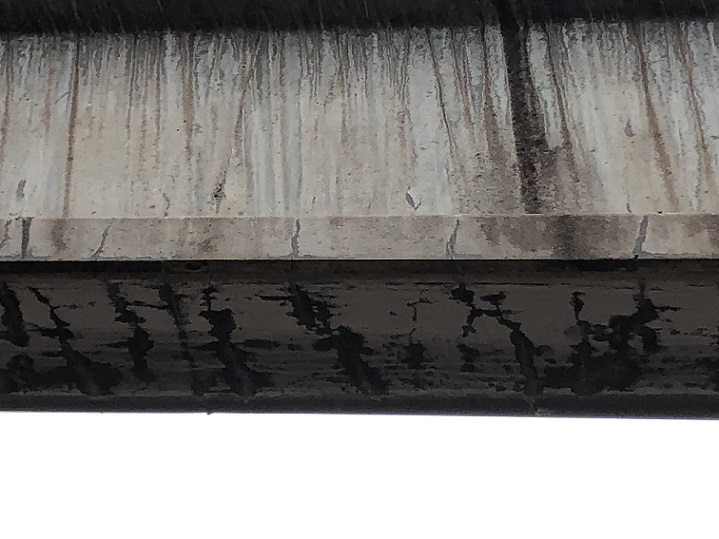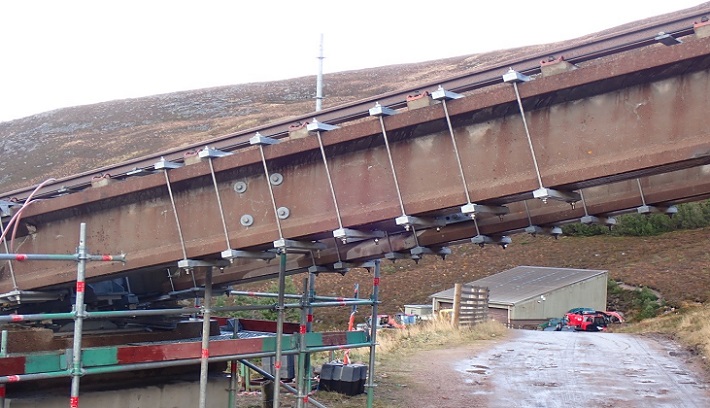I was pleased to receive this photo and comment at the weekend from a parkswatch reader who has been following the funicular story for several years and has experience of health and safety on North Sea oil rigs.

“I finally made it up the hill to the Cairngorm Ski Area. I think it would be fair to say I was appalled by the so called ‘repairs’ to the Funicular. More of a bodge than anything else, held together by screwed rods which I doubt are high tensile.

It would be interesting to see the stress calculations for these and how they are affected by extremes of temperature. Did they actually do stress calculations?
It was the end of operations when I was there and the last car came down as I watched. The support beam above me visibly flexed as the empty car passed over it, moving perhaps 5cm, the other side did not.
Closer inspection revealed what appeared to be numerous cracks in the underside of the beam flange, marked by lines of moisture. That is bad enough but what happens when this moisture freezes and expands making the crack worse? It can only further degrade the integrity of the beam and hence its strength. All the other beams I could see seemed to have the same problem. Also moisture entering a reinforced concrete beam will corrode the reinforcing leading to premature failure.
I will not be travelling on the Funicular ever again!

I always thought reinforced concrete was a really odd choice of material for this job. But I’m the wrong type of engineer to know better. Once water gets to the rebar and it corrodes it pushes the concrete apart from inside, it’s not fixable.
Concrete was not the original material of choice. It was supposed to be built with steel but HIE/ Morrisons asked the designer to change to concrete as part of a cost-cutting exercise! We all know how well that has turned out!
Two questions (1) if the deflection was that great with an empty carriage then how much would it bend if the carriage was full? and, (2) why did only one beam flex? That suggests the beam isn’t as strong as the opposite side and the train will lean over slightly at that point! It would be interesting to know the position of the beam, i.e. between which two piers?
Yes Nick – I can see you might be pleased to receive this information. Informed comment is always welcome and the comments with the photo are well informed. But perhaps not pleased when you consider the scale of disaster that might be unfolding. Minus funicular, the whole scenario becomes redundant – daylodge setup, visitor centre up top and so on. I am reminded of the words of the director of the Rocky Mountain National Park USA looking sadly with that very experienced eye. He visited the site along with me, Dave Morris and others. What did he think of the funicular? “There is only one thing you know about any piece of technology – it will go out of date. So you never put in anything you cannot take out – and you will never take this out.” That must apply to more than the funicular on Cairn Gorm.
Should the Health and Safety Exec not take a look. If it’s that obviously moving surely they’d be interested. How could it possibly passed safety standards. There must have been stress tests etc. Heading up tomorrow. Hope to God it doesn’t fail!
I follow, as do others, this sad tale of flawed design and construction and now, seemingly, a flawed (and somesay botched) repair job.
It is a damning indictment that the projects’ original structural designer (AF Cruden Associates) and Principal Contractor (Morrison Construction) have been sued in The Court of Session, Edinburgh, for £15m. An attempt, by HIE to recover costs associated with the repair.
Have you read the two posts on PW 20/10/2023 & 23/10/2023 titled “HIE and the funicular court cases”? At that time the court cases had not gone ahead and the two posts explain why I think they never will. The “I” beams appear to be the main problem, so why aren’t the manufacturers of those beams being sued or made to manufacure new ones? Because replacement would have made necessary dismantling of everything except the piers, making it cheaper to demolish the whole system. The fundamental problem remains and the “I” beams will require further strengthening if the train is to survive.
Beautiful mountains are better without us humans ruining them. Perhaps the Greens will suggest they could reroute the A9 over the top so everyone can drive up for free and enjoy the ruined mountain. Also put up some wind turbines on every mountain just to add to the beauty.